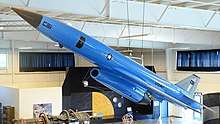Composite Engineering BQM-167 Skeeter
The Composite Engineering BQM-167 Skeeter is a subscale aerial target (drone) developed and manufactured by Composite Engineering Inc. (acquired by Kratos Defense & Security Solutions) and operated by the United States Air Force and certain international customer air forces (designation BQM-167I). It has replaced the Beechcraft MQM-107 Streaker (aka Kalkara in Australia).
History
The BQM-167 was developed and manufactured by Composite Engineering Inc. (now part of Kratos Defense & Security Solutions), and is constructed of carbon fiber and epoxy-based materials.[1][2]
Two prototype targets were built and test flown in 2001. The BQM-167A was selected as the next-generation Air Force subscale aerial target in July 2002. A total of six targets were built for use during the flight performance demonstration (FPD) phase with its first flight 8 December 2004. A total of 13 FPD launches were made into March 2006.[1]
First acceptance testing was completed in August 2006, then pre-operational testing consisted of 13 test flights using production targets from August 2006 - June 2007. The first BQM-167 air-to-air missile live-fire mission took place 7 February 2007. Initial Operational Capability was achieved in 2008. Each target cost US$570,000.[1]
Operation

The 82nd Aerial Targets Squadron operates and maintains the target at Tyndall Air Force Base, Florida.
The drone is land-launched using a rocket assisted takeoff and launched from a rail system, and recovered on land or sea using a parachute system. After assessment and refurbishment, the drone is placed back into service.[1]
The USAF has had 37 in inventory.[1]
UTAP-22
On 23 November 2015, Kratos completed the second flight of its self-funded Unmanned Tactical Aerial Platform (UTAP-22), a development of the BQM-167A converted into a low-cost unmanned combat aerial vehicle (UCAV). The test involved collaborative airborne operations with a manned AV-8B Harrier fighter for 94 minutes demonstrating command and control through a tactical data-link, autonomous formation flying with the AV-8B, and transfer of UTAP-22 control between operators in a tactical network and then to an independent control link.[3] The 6.1 m (21 ft)-long turbojet-powered aircraft can travel at Mach 0.91 (693 mph; 1,115 km/h) up to an altitude of 50,000 ft (15,000 m) with a maximum range of 1,400 nmi (1,600 mi; 2,600 km) and an endurance of three hours. It can carry a 159 kg (351 lb) internal payload, a 227 kg (500 lb) external payload, and has a 45 kg (99 lb)-capable weapon hardpoint on each wing. The platform is recoverable on land or at sea using a parachute system.[4][5] In May 2017, the UTAP-22 received the official name Mako.[6] The aircraft costs between $2-$3 million.[7]
Specifications
Data from
General characteristics
- Crew: None
- Length: 20 feet (6.1 meters)
- Wingspan: 10.5 ft (3.2 m)
- Height: 4 ft (1.2 m)
- Empty weight: 690 lb (313 kg)
- Max. takeoff weight: 2,050 lb (646 kg)
- Powerplant: 1 × 1x MicroTurbo Tri 60-5+ turbojet, 990 lbf (4.4 kN)
Performance
- Maximum speed: 0.93 Mach (600 kn (sea level))
- Cruise speed: 230 kn (sea level)
- Service ceiling: 50,000 ft MSL (15,000 m) 50 ft AGL min. / 8 m min.
9 G turns; recovered by a parachute recovery system either from land or water
Avionics
IR and RF Tow Targets; IR and RF Wing Pods; Chaff / Flare Dispensing; Vector & Scalar Scoring
References
- BQM-167A Air Force Subscale Aerial Target, USAF, 2009-05-20, accessed 2017-02-23
- BQM-167A brochure, KratosUSD, accessed 2017-02-23
- Kratos Completes Second Flight of Tactical Unmanned Aircraft - Ainonline.com, 9 December 2015
- Kratos breaking into the unmanned combat air vehicle market - Flightglobal.com, 5 May 2016
- Kratos gets green light to market potentially-armed Mako ‘loyal wingman’ drone to allies. Defense News. 1 May 2018.
- USAF Research Lab Has Released This Image Of Its Low-Cost Stealthy Drone - Thedrive.com, 19 May 2017
- Kratos’ Mako drone approved for sale to foreign militaries. Flight International. 15 March 2018.
- BQM-167A Air Force Subscale Aerial Target, Kratos, accessed 2018-08-08
- Kratos Unmanned Systems Division - BQM-167I[1]
- BQM-167I brochure, KratosUSD, accessed 2017-02-23